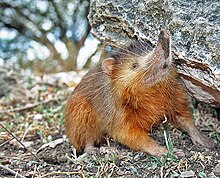Solenodon paradoxus
| Hispaniolan solenodon | |
|---|---|
 |
|
| Hispaniolan solenodon | |
| Scientific classification | |
| Kingdom: | Animalia |
| Phylum: | Chordata |
| Class: | Mammalia |
| Order: | Eulipotyphla |
| Family: | Solenodontidae |
| Genus: | Solenodon |
| Species: | S. paradoxus |
| Binomial name | |
|
Solenodon paradoxus Brandt, 1833 |
|
 |
|
| Hispaniolan solenodon range | |
The Hispaniolan solenodon (Solenodon paradoxus), also known as the Haitian solenodon, or agouta, is a solenodon found only on Hispaniola, the island shared by Haiti and the Dominican Republic. It was first described by Brandt in 1833. A similar but smaller species, Marcano's solenodon (S. marcanoi), once lived on the island, but became extinct after European colonization.
The Hispaniolan solenodon looks much like an oversized shrew; males and females are similar in size. Adults measure 49 to 72 cm (19 to 28 in) in total length, including a tail 20 to 25 cm (7.9 to 9.8 in), and weigh about 800 g (28 oz) on average. Although they are somewhat variable in colour, they are typically dusky brown over most of the body, with a paler underside and reddish fur on the sides of the head, throat and upper chest. The tail, legs, snout, and eyelids are hairless.
The forelegs are noticeably more developed than the hind legs, but all have strong claws useful for digging. The head is very big in relation to its body, with a long rostrum and tiny eyes and ears partially hidden by the body fur. The nostrils open to the side and the snout has about a dozen long whiskers, up to 7 cm (2.8 in) in length, with a few smaller whiskers further back on the head. A unique feature is the os proboscidis, a bone extending forward from the nasal opening to support the snout cartilage; this is not found even in other closely related solenodons.
The dental formula for the species is 3/3, 1/1, 3/3, 3/3 = 40. The second lower incisor has a narrow tubular channel that is almost entirely enclosed, through which flows a venomous saliva secreted by the submaxillary gland. Although the exact chemical composition of the venom is unknown, injection of 0.38 to 0.55 mg of venom per gram of body mass has been shown to be fatal to mice in two to six minutes.
Hispaniolan solenodons have patches of skin rich in apocrine glands on the thighs. The secretions of these glands are used in communication between individuals.
...
Wikipedia

